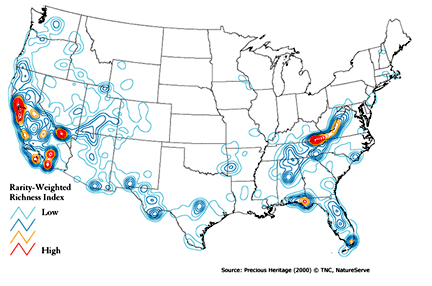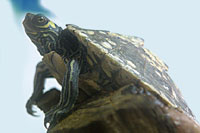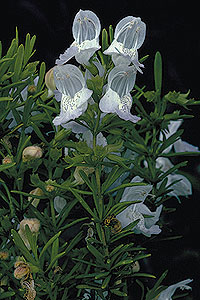Biology:
Plants, Animals, & Habitats - We live in a hot spot of biodiversity
The Florida Panhandle is one of the nation's six "biological hot spots," which means it has many rare species, and many of these rare species are found only in small areas. (The other five areas are Hawaii, the southern Appalachians, the San Francisco Bay area, the Death Valley region, and southern California.) Here's our tally:
 Biodiversity hotspots in the United States (from Precious Heritage (2000), copyright The Nature Conservancy and NatureServe, reproduced with permission) |
(Species are listed below.)
The Apalachicola River drainage basin supports more reptile and amphibian species than anyplace else in the United States and Canada, with more than 40 amphibian and 80 reptilian species, according to the Apalachicola National Estuarine Research Reserve (ANERR). See also Means (1977).
Why do we have so many?
Is it because of our warm climate?
Is it because the region has so many different types of natural communities?
Is it because of the abundance and variety of fresh, brackish, and salt waters -- from clear spring runs to silty river flows, from tiny temporary ponds to Florida's biggest river, along with two of the continent's most fertile bays where fresh and salt waters mix?
Is it because of its strategic location, which is influenced by several different physiographic regions (the Appalachian Mountains, both the Atlantic and the Gulf coastal plains, the Piedmont, and peninsular Florida)?
Is it because of the region's complicated geological history?
Is it related to the history of humans in the area and how they've used and managed the land?
No one can say for sure. The region's high species diversity probably has something to do with all these factors, but scientists have not yet come up with a definitive answer.
We do know that human activities affect the region's native plants and animals and their habitats. Converting land from natural communities to agricultural, industrial, and residential uses changes the kinds of plants and animals that can live on and around them. Changes in the pattern of water flow and in the quality of that water affects species that live on land as well as those that live in the water. Some lands need natural processes of renewal, such as daily tidal flooding or semiannual burning, in order to provide good habitat.
The first step in figuring out how to maintain the region's status as a biodiversity hot spot while accommodating growing economies and human populations is to know what plants, animals, and habitats are out there, what their needs are, and what we can do to manage them -- and to enjoy them.
Species found only in the ARROW region:
 Barbour's map turtle would make a great mascot for the ARROW region This species is found only in the in the Apalachicola, Chattahoochee, Flint, Chipola, Ochlockonee, and Choctawhatchee river systems. (photo by Karla Brandt) |
 Apalachicola rosemary, a member of the mint family, has been found only in Liberty County (photo by Gary Knight) |
Other rare species in the ARROW region:
Sources:
Chafin, L.G., J.C.P. Hancock, and G. Nelson. 2000. Field guide to the rare plants of Florida. Florida Natural Areas Inventory, Tallahassee, FL. Online at FNAI's website.
Hipes, D., D.R. Jackson, K. NeSmith, D. Printiss, and K. Brandt. 2001. Field guide to the rare animals of Florida. Florida Natural Areas Inventory, Tallahassee, FL. Online at FNAI's website.
Klein, B.A., L.S. Kutner, and J.S. Adams (eds.). 2000. Precious heritage: the status of biodiversity in the United States. Oxford University Press, New York.
Means, D.B. 1977. Aspects of the significance to terrestrial vertebrates of the Apalachicola River drainage basin, Florida. Pp. 37-67 in Livingston, R.J., and E.A. Joyce, Jr. (eds.). Proceedings of the Conference on the Apalachicola Drainage System. Florida Department of Natural Resources, Marine Resource Publication 26.
Available by request from the Fish and Wildlife Research Institute.
Note: The content of the website has not been updated since 2005. The site remains online for it's value as legacy content and is unlikely to be updated.